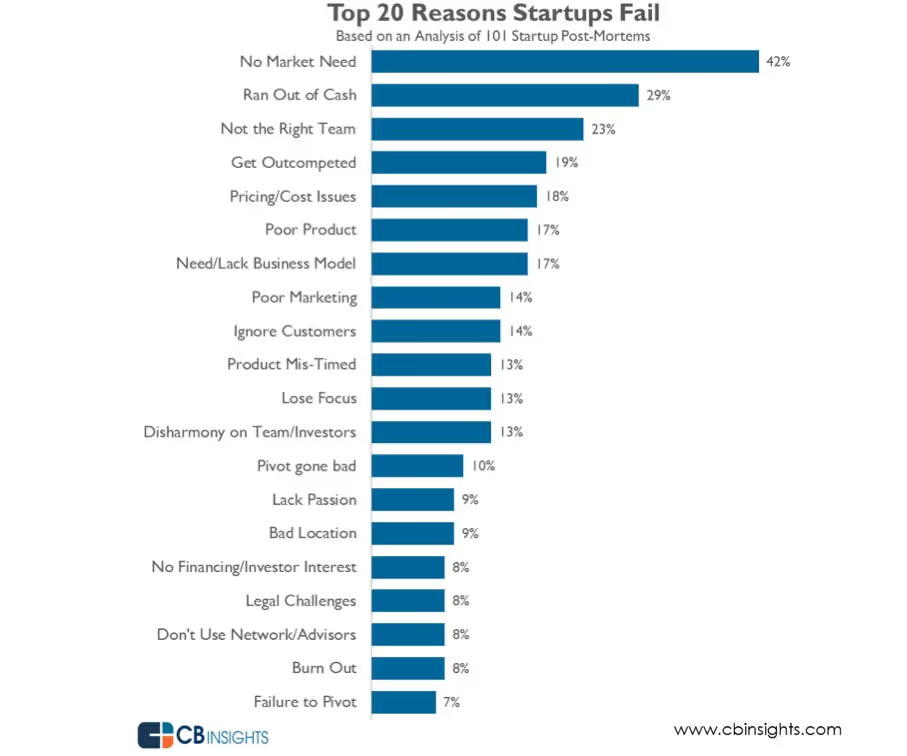Early adopters play a vital role in the growth and prosperity of your startup. Not only do they provide your first source of revenue, but also provide impactful feedback at a time when it's still possible to make changes to the direction of your product. In fact, many well-known businesses had to pivot rapidly after receiving feedback from early adopters, which led to the thriving businesses they are today.
Where your early adopters come from can vary greatly. Here's three very different examples about how successful startups found their very first customers:
Tinder: The dating app, Tinder, kicked things off by going where the people most interested in dating would be (colleges). The CMO of the time, Whitney Wolfe, would make presentations at both sororities and fraternities, encouraging students to sign up. At the end of her campus tour, Wolfe had 15,000 users on Tinder and the reputation of the app was growing, quickly.
Nasty Gal: An ecommerce platform that at one point reached $100 million in sales—started out with, effectively, no budget at all. Nasty Gal would sell items to a tiny audience on eBay, listening to feedback and making tweaks. Although the company has since gone bankrupt, it is a near-perfect example of refining your product with early adopters before launching on a larger scale.
Loom: The popular screen recording tool, Loom, started out as a different product to the one you see today. Loom gained an impressive 3000 early adopters following its ProductHunt launch, which enabled the platform to iterate on early feedback and improve their product before launching to a larger audience. The company has since grown to 14 million users, however, took over four pivots in product direction to get there.
In this article, we unpack who early adopters are and why they are so crucial to the success of your startup, and then we share tactical methods to help you find yours.
Let’s dive in!
What is an early adopter?
An early adopter is a person who eagerly embraces and uses new technology or products before they are widely available. Early adopters tend to be very influential in their communities, as they spread the word about new technologies and create excitement and interest around them.
Some people may view an early adopter as being somewhat of a risk-taker, since they are often the first consumers of new products. However, their “early adopter” status can often be rewarding as they’re the first to use exciting new technologies or products. Early adopters tend to be optimistic—able to see through short term product deficiencies and see the long term vision.
Their status as an early adopter may also mean they get to help shape the development of new products and services, as they often provide feedback to companies on what they like or dislike about a product.
Why early adopters are critical to startup growth
Early adopters can influence your product and the trajectory of your startup more than any other customer. They provide invaluable feedback, can fast-track product-market fit, and their enthusiastic adoption of your product can help generate buzz and interest among other potential customers, which can drive more sales. Treat them right and they’ll be the foundation that your entire business is built on.
1) Early adopters provide critical feedback
Your early adopters know the problem that they’ve got, and they see the potential for your product to resolve that problem. Chances are, though, that no matter how well you know the space, those early adopters, who are all living with the problem, will have some insights about how you can do things better, resulting in a better product over its first few iterations.
2) They’re your best early marketing resource
People talk about the things they like. Every successful social media platform broke into the mainstream because the first users convinced their friends and family to sign up. Research suggests that 92 percent of consumers trust recommendations from family and friends, and 72 percent of consumers will share a positive experience with at least six people. That is a reach that no other form of marketing could deliver to a cash-strapped startup.
3) They’re the first test of the product-market fit
Most people assume that the biggest cause of startup failure is running out of cash, but that’s actually #2. The biggest cause is that it turns out there is no market need for the product.
No matter how well you research and prepare, you’ll never know if there is truly a market for your product until you put it in the hands of the users it was designed for. As soon as you share your product with early adopters, they’ll quickly validate or void your hypotheses. Luckily, they’re generally very patient with realistic expectations of the first version of your products. But they’re invested. Because if you succeed then they’ll succeed. So they’re willing to support you until you find the elusive product-market fit.

Who are your early adopters?
How did the Tinder team know that single college students were their ideal first market? It starts, once again, with the problem. What is the problem that your product will solve? The early adopters will be the people desperate to find a solution for it.
The profile of the early adopter looks like this:
- They are being challenged by the problem.
- They know that they have it–this is important because:
- They are actively seeking solutions to it.
You should also be looking for people that have a sense of urgency about their search. People are inherently distrustful of the unfamiliar, and here you are asking them to support a product they’ve never used from a company they’ve never heard of before. For them to overcome this hesitancy, they need to consider it a priority to solve the problem. It turns out that for single students, finding people to date was a particularly urgent problem. And Tinder was there to fix it.
How to find where these people are
Once you have a profile of your customer, and understand who might be particularly challenged by a problem and need an urgent solution, the next step is to try and get into their heads a little. Where would these people go looking for a solution to their problem? Where would the proactive consumer assume they can find information?
That's your “watering hole,” and that’s where you need to bring your startup.
Some great examples of “watering holes” for acquiring early adopters
1) Start with online communities
In the modern era, the first port of call for finding communities of people is online. Just about every kind of person, with just about every interest imaginable, has a place on the Internet that they call home. Subsequently, social media is a good place to start the hunt for early adopters.
- Facebook Pages: Though you could argue that the Facebook star is fading, the social media giant remains a behemoth for now, and has some incredibly useful features for startups. Setting up a Facebook Page is free, for example, and it offers some potent SEO features. Make sure you get the page description right, use the right keywords, and post regularly, and let the algorithms lead active searchers to your page.
- Specialty Websites and Forums: If you’re into video games, you’ll visit a Website like IGN. If you like music creation, then you’ll have Soundcloud on your daily visit list. TripAdvisor or Lonely Planet are favorite locations for travelers. Most of these Websites also have areas where the community can interact–either comment sections, or dedicated forums. Get on those and start talking to people!
Forums are also a great place to find early adopters. You can trawl through Quora, Reddit, Indie Hackers and find threads where people are asking for solutions to the problem you're solving.
It’s important that you don’t just talk about your product and business–that’s considered both spammy and rude–but if you become a genuine member of the community, answer and ask questions, you’ll find opportunities to organically talk about your product over the course of weeks and months. - LinkedIn: If your business is a B2B organization, LinkedIn offers a lot of value. You can establish your brand there, blog about topics of interest, and search for people that have relevant job titles and sectors to pitch to directly.
2) Demonstrate the product on crowdfunding websites
To a pre-seed startup, the ability for platforms like Kickstarter and IndieGoGo to raise capital is almost secondary to your ability to create video and demonstration material and put it in front of prospective customers. Consumers that are on these websites are often looking for things that they can’t find on the market, and are receptive to the idea of businesses that haven’t launched yet. This creates a unique culture around these sites that makes them a particularly useful resource for founders.
Even if your crowdfunding campaign is unsuccessful, you will end up with a mailing list that you can start to target with further information.
3) Get out there and physically visit people
If you know that your target early adopters are going to congregate in a particular location, then you can physically travel to them to make the pitch. If you’ve working on a new piece of fitness equipment, then you could drop in at a gym during a class. If you’ve got a singles dating app in the pipeline, like Tinder, then a college tour makes a lot of sense.
Think about what your target audience does with their days and go to them there. Putting a face to an unfamiliar brand can help to personalize the project for early adopters, and that can help get them become more receptive to your product.
4) Find your first brand ambassador
Across all social media networks, there are people that stand out and command attention. These “influencers” gain large followings of people that are interested in their area of speciality. While you probably won’t be able to afford the kind of fee that a top-tier influencer will command, there are plenty of smaller, more niche interest influencers that will only ask for a modest fee to put your startup in front of their audience. Do some research around influencers that operate in your niche and reach out to them.
5) Don’t neglect your own website
A well-maintained website that uses the right keywords and publishes frequently and of a high quality gains the benefit of a high ranking on Google, and that will often be the first place that people go when looking for a solution to their problem. One of the great things about running your own website is that you’ve got complete control over the message, and by implementing a blog or similar, can establish yourself as a subject matter expert, which can boost the perception that early adopters will have of your brand.
6) Consider PR but don’t rely on it
Recruiting a PR agency is expensive and beyond the scope of most pre-seed startups. What you can do, however, is study how press releases look and read, write your own, and then create a shortlist of media targets, and editors to reach out to with it.
Don’t reach out to the big, national, general interest papers. The chances are that they won’t be interested, and even if they are, most of their readers won’t fit the early adopter profile. However, there are a lot of specialist media publications that cover just about every niche, and the people that read those are intensely interested in the sector. Pitching to a media editor is not dissimilar to pitching to an investor, so use it as a learning opportunity, and see if you can get some media buzz going.
7) Leverage your networks
If you’ve reached the point that you’re founding a startup to address a problem, the chances are that you’ve been involved in a sector for long enough that you’ve got personal and professional connections in it. Reach out to them and see if they would be interested in your business, or if they know anyone that would. Remember that with this first wave of early adopters, you’re only looking for a small foundation. A robust professional network could get you very close to your target number by itself.
How do I know which approach will work for me?
The pathway to finding the early adopters is greatly dependent on the type of business and the sector that it’s in. A B2B startup targeting the software industry would have more success in leveraging LinkedIn networks than a B2C company in the entertainment sector. A medical devices company would have more chance of finding early adopters at a health specialists convention. Finding the best approach really comes down to research and following the trail of breadcrumbs to the communities that you’re looking for.
Won’t they want to see a product?
Your early adopters will often love the idea of being involved in a product that adds value to their lives right at the start. This is particularly true when there’s a feedback loop built into the interactions and it looks like their suggestions and ideas are influencing the way the product moves towards the MVP.
In other words, don’t let the lack of a product stop you from starting to reach out to these communities now, and start building that buzz towards the big reveal of your MVP.












